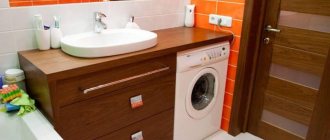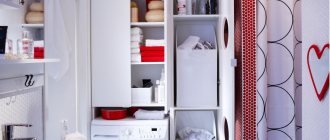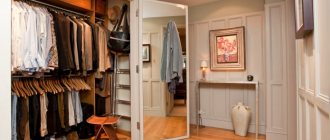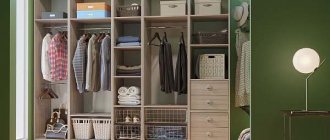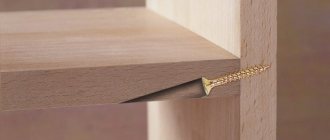Tee in the bathroom between the machine mixer. The position of the electrical outlet is also a point that should be taken into account: it is better if it is placed next to the machine. If it is not there, you should consider installing it. The use of an extension cord is not advisable due to the dangerous proximity of water.
Socket next to the washing machine.
Cabinet for a washing machine in the bathroom - features and benefits
Furniture manufacturers offer a suitable solution. It is enough to install a cabinet for the washing machine in the bathroom. This will help you create an aesthetically pleasing and well-maintained workspace.
There are other advantages:
- If the usable space allows, you can hide a dryer, water heater and other equipment in such a cabinet;
- Aesthetics. The cabinet will help hide all the pipes and cables necessary for the proper operation of the equipment. The low attractiveness of such elements can seriously spoil any interior;
- Everything you need is nearby. Additional sections with adjacent shelves allow you to store laundry detergents, conditioners or a basket with dirty laundry nearby;
- Simplify the cleaning process. No need to wipe between the bulky machine and the water pipe;
- Reduce noise levels. The ribs dampen some noise and vibration. In apartments with good audibility this will not be superfluous.
Types of cabinets for washing machines
Wall cabinet above the washing machine
Models of cabinets above the washing machine in the bathroom can be of two types:
- Blocks with shelves that easily fit underneath are suspended above the washing machine. Suitable for very compact spaces;
- The folding section goes around the washing machine in the shape of the letter G. At the bottom side there is usually a compartment with a basket for dirty laundry. There is also a compartment with shelves at the top. A more practical modification. But this requires more space. Weight increases.
All of them require fastening directly to the wall, without resting on the floor. To do this, choose only solid walls with high-quality finishing. It is recommended to hang on supporting structures. Overloading a weak wall can cause it to partially collapse.
Lockers that do not exceed the width of the machine itself look harmonious. The height can be any. When hanging the cabinet, leave enough space between the bottom and top of the washing machine. This way you can completely bypass the difficulties with vibrations and overheating.
Pay attention to the selection of fasteners. Weak hinges without hinges will not fit in a full wooden cabinet. Whereas a plastic sash cannot be secured with complex corners of increased strength. Focus on the weight of the base material. Fasteners must be moisture resistant.
Floor-standing models of cabinets for washing machines for bathrooms
The next popular type is a cabinet for a washing machine in the bathroom. They have no bottom, and the back wall may be completely or partially absent. This is due to the heavy weight of the equipment and the need for pipe drainage. A rarer type is the model where the technique is at the top. It looks original, but will cause you a lot of hassle if you have to lift the laundry when you load it into the drum. It is also inconvenient to pour the powder, since you will not see the compartment under it at all.
The upper niche for equipment creates a danger of it falling. The manufacturer must be truly serious, and the quality of the materials must be impeccable. If you decide to install only this option, constantly monitor the fasteners and strength of the screed.
Compared to wall-mounted ones, the floor will require more space. But they will provide you with a complete and spacious storage system. It is not necessary to focus on a load-bearing wall. Choose free.
The height of the cabinet can vary from 1.7 to 2.1 meters. The width depends on whether the cabinet has one or two sections. But you can be sure that it will be at least 65 cm.
Built-in models
A built-in cabinet for a washing machine in a bathroom is a rare occurrence. This is due to lack of space. But if you are lucky enough to have a spacious bathroom, then installing such a cabinet will bring you many benefits. Offers maximum flexibility in organizing shelves and drawers. You can choose everything strictly according to your taste. The absence of a frame will slightly increase the niche for the car. It’s a pity, but such a space-efficient option is very difficult to place where it is really needed. Be sure to level the walls and tiles. If there are significant differences in floor level, a concrete screed will help. If the problems are related to old, protruding and chipped tiles, it is easier to disassemble them than to straighten them.
Features of choosing a cabinet for a washing machine
The most important element in terms of size is the size of the niche for the equipment. They should exceed the size of the camera body by 2-5 cm. At the back you will need to retreat 10 cm, this will ensure normal air circulation. In addition, the furniture will not experience vibrations in rotation mode. On average, the height of such a device reaches 90 cm, and the width and depth are 60 cm.
It is also taken into account whether the machine will be closed by dampers. If so, then there should be 2 of them. A large door can extend furniture hinges. The depth still depends on the thickness of the material. In this regard, built-in washing machine options are ideal. They have hinges for hanging doors. But this can make it difficult to fall asleep in the dust. In this case, pour it into the trash. This technique is allowed by most manufacturers. Also keep in mind that some materials may have a warming effect. This is not particularly desirable.
It doesn't matter whether you buy a cabinet in a store or create one to order. You must first buy the equipment. This will avoid all the difficulties with subsequent rework.
How to position
When installing a refrigerator in the hallway, consider the following:
- While working, it gives off heat. Therefore, you cannot place it closer to the wall than 10 cm;
- Do not allow the case to overheat. It should be located away from heating radiators, ovens and stoves - at a distance of at least 50 cm. It should be protected from direct sunlight;
- It is advisable to connect equipment directly, without extension cords or adapters. Therefore, the outlet must be nearby;
- The equipment should be installed on a flat surface. This will help avoid noise during its operation;
- Convenient hanging of refrigerator doors and the ability to open them unhindered is another factor that affects ergonomics.
If you decide to place the refrigerator in the hallway, you can choose one of the options:
- Hide it in the closet;
- Embed;
- Just put it against the wall.
In the closet
If the size of the room allows, you can put a cabinet with a refrigerator inside. This option helps maintain a unified hallway style. This solution turns the unit into invisible, and simple furniture turns out to be a box with a secret.
Refrigerator hidden in the closet.
Miniature models can be conveniently placed in a wide cabinet, which can belong to any style direction - from classic to loft.
Refrigerator in the loft style hallway.
Built-in
You can hide equipment in different ways.
- There are special models that require installation in a cabinet. Their outer side has a special fastening system where the facade is installed. This is how the equipment is integrated into the existing furniture ensemble;
- A refrigerator in a niche will help you make the most of the hallway space. The niche can be closed with sliding doors, organizing a wardrobe. A tall “barn” door on wheels will give the interior a rustic feel;
- If the hallway has a storage room of a suitable size, you can place the equipment there.
Near the wall
Often the size of the room does not allow you to hide the refrigerator. Then it is placed against the wall. Do not forget that the distance to the wall must be at least 10 cm. The handles must not interfere with movement. It is necessary to achieve maximum comfort when opening doors: nothing should limit them.
Purpose
Saving space is a decisive factor when choosing furniture for general built-in appliances. A competent project, the original design of the wardrobe model allows you to create the illusion of free space, as well as arrange the products compactly and ergonomically. In most cases, washing machines are installed in the kitchen or bathroom, built into specially designated niches or modules. This cabinet helps solve the following problems:
- saving space. The real challenge that almost all homeowners face is the space-saving setup of large apartments. Installing a washing machine inside a cabinet frees up space;
- aesthetics of the work area. Regardless of the room in which the furniture will be installed (kitchen, bathroom), the room “wins” in aesthetics. Equipment will not attract the attention of guests if it is hidden behind beautiful furniture doors;
- rational use of free space. There are furniture models for household appliances with additional sections, shelves, and drawers. The internal content depends on the size of the installation space. Inside you can install baskets, nets, shelves for storing detergents;
- spectacular room design - furniture for rooms with high humidity can be made from moisture-resistant materials, doors can be decorated with decorative facades, the product can be designed in a suitable style so that all the furniture in the room looks like a single whole;
- Maintain order and ease of cleaning in the room. The neat arrangement of equipment inside the cabinet simplifies the process of wet cleaning in the bathroom or kitchen. Housewives can place various personal hygiene items and household chemicals on the shelves.
An additional advantage of installing a washing machine in the interior of a cabinet is the sound insulation of the operating equipment. Typically, washing machines with a spin option are noisy. Furniture walls create a certain barrier to noise and vibrations, performing sound-absorbing and sound-proofing functions. The top panel of the built-in cabinet under the sink can be used as a convenient shelf for storing various accessories, small items and hygiene products.
Design
Modern cabinet designs are very diverse. They are made from different materials, vary in shape and size, have all sorts of colors, include patterns and illustrations. This allows you to adapt the furniture to almost any existing interior. It’s easy to verify this; just look at the products of well-known brands, for example, ikea.
When choosing suitable furniture for a washing machine in the bathroom, you should take into account the size of the equipment, the design features of the room, and the prevailing style. It is advisable to install sections for a large floor or wall cabinet with many shelves when homeowners have no doubt about saving space. Otherwise, it is better to use a small cabinet or pencil case.
The best option, distinguished by its beauty and luxury, would be a massive oak cabinet. A product made from natural wood will last quite a long time. But it should be noted that its price is very high. If the family budget does not allow you to purchase products made from natural wood, you can pay attention to structures made of MDF or chipboard, treated with special waterproofing agents.
Universal kitchen
The washing machine requires connection to water and sewerage. Utility lines run in the wet areas of the apartment, so placing a washing machine in the kitchen is a legal option.
But how convenient is this, since you need somewhere to put a basket to collect laundry and store cleaning products?
The washing machine can be installed in the bottom row of cabinets, and the laundry can be collected in the hallway or in the nearest room.
It is best to use a special washing machine that is built into a cabinet and covered with a panel. This makes the washing equipment invisible.
Types of cabinets and placement methods
The choice of a specific cabinet for a washing machine depends on several parameters. First of all, the type of washing machine is taken into account. Top-loading models with an opening lid cannot be hidden under a sturdy countertop or sink. Floor and wall-mounted furniture options are suitable for these products.
Front-loading units can be placed in built-in, floor-standing, or built-in cabinets. You can buy ready-made furniture along with a washing machine, but it is better to make them individually, taking into account the dimensions of the room, the dimensions of the product, sections and the necessary additional shelves included.
Mounted
Wall cabinets can be part of a furniture set or serve as a separate element. In terms of design, they are practically no different from floor-standing models; they have back and side walls, an open or closed front. The main feature is the method of mounting the module, which should not touch the floor. The cabinets are attached directly to the wall using special fasteners.
When choosing a suitable model, special attention should be paid to its size. The width of the furniture must correspond to the technology. At the same time, wall cabinets can be placed on top of top-loading and front-loading machines. Inside you can place shelves, rods, drawers where personal hygiene items, bathroom accessories, and household chemicals are stored.
Among the main advantages of this type of cabinets are their small size, limited access for children to objects inside, and they also allow rational use of useful wall space. This is an ideal option for small spaces, however, due to their design features, these models do not allow storing heavy items.
Cabinets can only be installed on hard surfaces. The most suitable place is a load-bearing concrete or brick wall. Fragile plasterboard partitions cannot withstand the load.
Floor-standing
Basic cabinets are the most popular among customers. They are reliable, easy to use and can have many additional sections. For small bathrooms, cabinets are used, the minimum width of which is 60 cm, and the height is limited only by the ceilings. However, narrow and tall cabinets should not be overloaded, as they may tip over due to vibration.
An alternative to tall cabinets are cabinets. The lid of the most compact of them can be equipped with a washbasin, and a washing machine can be placed under it. There are also models on sale with a countertop with a built-in sink. The height of such furniture is only 90-95 cm, depending on the size of the built-in equipment.
Finished products vary in color, shape, material, and size. In spacious rooms, you can build durable large cabinets, which consist of drawers, sections for washing machines and dryers, and upper shelves. Based on the way the furniture is positioned relative to the wall, linear and angular models are distinguished and based on the type of doorway: hinged and sliding.
Built-in
Built-in wardrobes do not have a back wall, and some models do not even have side walls. Their function is performed by the walls of the room themselves. There are panel and frame structures. The first type is usually installed in a niche or in one of the free corners. The second type is most often located along the wall; it can be used as a separate type of furniture.
The height of the products is usually limited by the ceiling, which allows for the most efficient use of free space. The main advantage is stability, which allows you to place equipment even on the top shelves. The main disadvantage is stationarity. During repair work, disassembling the compartment is quite problematic.
The designs look very modern and attractive, but experts recommend installing such a cabinet only after careful planning and accurate completion of all measurements. The strength of the furniture allows you to place 2 cars at the same time. But to avoid loosening during operation, it is better to choose quiet models with minimal vibrations.
Classification
The multifunctional design of a washing machine cabinet comes in different types. The features of the built-in module are determined by the availability of free space, the dimensions of the device, and the interior of the room. The basis for choosing a design is:
- Ready-made models from built-in equipment sales centers.
- Custom-made cabinets, the parameters of which take into account the needs of the client.
Scope of application of computer cabinets, main models and their features
Equipment in the cabinet is placed from the standpoint of practicality, aesthetic appeal, and ease of use. Most often, a bathroom, kitchen, hallway or toilet is chosen for installation. There are several classifications of cabinet models, among which those who want to install a built-in washing machine will definitely find a suitable option.
Ready
Custom
By location
Installation of the structure and fixation of cabinets is carried out in different ways, which determine the classification of furniture by location:
- Mounted option. The cabinet does not stand on the floor; it organizes the space above the washing machine. As a rule, the width of the shelves and appliances coincide, so their visual combination in a small space looks harmonious. The structure most often has a rectangular shape, less common are corner structures or in the shape of the letter U, when the side sections cover the machine and maximum connections, and the free space is used for a laundry basket. A front-loading washing machine is suitable for this cabinet model. Hanging structures are mounted on a solid base in the form of a load-bearing wall. Furniture cannot be mounted on plasterboard partitions or fragile floors.
- Base cabinet. The structure, standing on the floor, covers the washing machine with all communications with side panels and doors. The floor cabinet can be successfully combined with open and closed sections and shelves. The functional complex is similar to a chest of drawers or a hinged cabinet. The convenience and compactness of designs with a width of 60–80 cm are attractive for small bathrooms. The floor cabinet is equipped with a countertop, combined with a chest of drawers, including a spacious storage system, and they often choose to install a sink above the washing machine.
- Pencil case. The model is usually built into the bathroom or kitchen. The lower level is occupied by a machine, the middle level is occupied by a drying unit, and the upper level is occupied by washing products and bath accessories. The structure is allowed to be high, but excessive loading of the upper shelves leads to a shift in the center of gravity - the structure may collapse under the influence of machine vibration. Before installing a tall pencil case, you should study the manufacturer's recommendations and cabinet labeling. Hinged doors are installed if there is free space for passage.
- Kitchen unit module. Full or partial installation, stationary installation is chosen taking into account the free space and interior features. Use the unoccupied space under the countertop as an open or closed module. Beautiful front doors add unity to the design, but only a front-loading machine is allowed in a closed cabinet. Models with vertical filling are placed at the end of the kitchen unit, in the form of a bar counter.
Interior compatibility of cabinets in wenge color, placement nuances
The location of the washing machine should be chosen taking into account safety and convenience. To remove the hoses, partially cut out the cabinet wall.
The base for the washing machine must be especially strong, as it can be destroyed by vibrations.
Mounted
Floor
Pencil case
Kitchen module
By design and shape
Ready-made models of furniture for washing machines fit organically into spacious hallways, kitchens, and bathrooms. Limited space is due to the individual dimensions and compactness of the cabinet. In all cases, the attractiveness of the modules lies in their compliance with the overall style of the room. In terms of form, the following are in demand:
- corner models;
- vertical straight cabinets;
- horizontal structures that combine a sink, shelves, and open and closed storage systems.
In small rooms, to save work space, folding cabinet fronts or sliding doors of a compartment system are installed.
The originality of the design should not interfere with the operation of the washing machine. The priority aspects are the reliability and safety of equipment operation.
Angular
Vertical
Horizontal
Materials and components for making a cabinet for a washing machine with your own hands
To make a cabinet for a washing machine with your own hands, it is better to choose moisture-resistant materials. This is especially important when designing furniture for bathrooms, where there may be high humidity.
Let's consider all possible materials of manufacture:
Chipboard. If the washing machine is built into the kitchen furniture, you can do this using regular high-density laminated chipboard. Without direct contact with water and without exposure to condensation and steam, chipboard can well serve as the main body material for a cabinet or toilet.
MDF. Laminated MDF panels are much more expensive than chipboard, but they fully justify their cost in terms of moisture resistance and convenience in the manufacture of bathroom furniture. But mainly MDF is used as a material for facades and tabletops, for decorating furniture facades. MDF can be covered with plastic or painted with enamel. In cheaper options, it is covered with PVC film.
Beam and panel for furniture. With a varnished or varnished surface, impregnated wood serves as a fairly moisture-resistant material. In addition, wood allows you to create lightweight and practical designs of shelves and shelving that fit beautifully and harmoniously into the bathroom interior. If desired, they can be supplemented with plastic and MDF countertops, chipboard shelves, glass, and metal baskets. You can make a radically different cabinet for a wooden washing machine with your own hands - a massive and durable structure, using a thick furniture panel.
Fake diamonds. It is primarily used to create streamlined, streamlined countertops with integrated sinks. Can also be used for furniture edges and shelves in combination with other furniture materials.
Plastic panels, drywall, tiles and other finishing materials. A built-in cabinet for a washing machine can become part of the bathroom interior. For this purpose, its body was built using repaired construction and finishing materials. The inside of the wardrobe can be supplemented at your discretion with shelves, drawers, baskets, and the facade can be decorated with curtains, sliding or hinged doors.
Metal and plastic construction. Cabinets made of metal profiles with shelves can be purchased ready-made. In addition, various plastic baskets, containers and shelves greatly expand the functionality of the bathroom and can be part of a built-in wardrobe.
What materials can be used?
The cabinet can be made from:
- furniture board,
- wood,
- glass
You should choose materials that are resistant to high humidity. Every furniture maker can cope with this task.
Doors are made from:
- furniture board,
- wood,
- glass,
- plastic,
- may look like blinds made of plastic or metal.
The following idea will ensure proper ventilation of the machine. Experts recommend opening the door at night after finishing washing, but people often forget to do this, and an open door can cause injury. To solve these problems, you can install special doors that allow air to pass through, providing round-the-clock ventilation.
Choosing a location for installation
The rules for installing built-in equipment require proper connection of communications. In this regard, it is more convenient to install the washing machine in the kitchen or bathroom - there is a water supply nearby and a sewer system for drainage. If the installation is in a hallway, you must first wire the system and then install the cabinet. A separate laundry room can only be installed in large houses/apartments. Basic rules for choosing an installation location:
- the best option is the bathroom. You can implement the idea in several ways: remove the toilet, put in its place a shower stall and a vertical housing for the washing machine (the material of the cabinet must be moisture resistant), mount a corner structure with additional modules, shelves, install compact equipment under the sink: sinks are mounted on the countertop or installed above;
- A rational idea is to install a washing machine in the kitchen. In a spacious room, the wardrobe is mounted separately. In a small room, the work area consists of a dryer and machine on one side of the line, a dishwasher, microwave oven, and other kitchen appliances on the other, the central part is a sink, and wall cabinets. Another option is to install the interface machine on the end of the headset;
- a practical solution is to install a cabinet with a washing machine in the hallway (corridor). If the room is narrow, built-in furniture will make the entire length of the “short” wall functional and simple. The square corridor is equipped with a wide straight or narrow corner structure so that the cabinet opening does not interfere with the entrance/exit of the room. In the corridor, the unit is closed with facades, otherwise the machine looks out of place and unattractive;
- There is no alternative situation: installing furniture in the toilet. It’s not difficult to imagine a stand-alone machine in the bathroom, but a wardrobe is a serious matter. There are several solutions: a compact cabinet for household appliances in the corner; you can install an upper cabinet above the washing machine, and hide various accessories, toiletries, detergents, and household chemicals on the shelves.
Despite the fact that washing machines are difficult to place in small spaces, the equipment fits well into furniture with a built-in installation option. This allows you to free up space, neatly place the washing unit and use the space to maximum benefit. It is important that the wardrobe can be made to fit any size of equipment, give the product an interesting look and fit organically into the decor of the room.
Connection to water supply
If you can connect the drain from the equipment either directly to the sewer or using a siphon, then there are several options for connecting water:
Crimp coupling for connecting metal pipes. A hole for connection is created in the pipe, a coupling is placed on the pipe, and a ball valve with a 3/4 threaded outlet is placed on it. An inlet hose is connected to the outlet.
Crimp coupling for connection to metal-plastic pipes. After cutting into the pipe, the fitting is connected. The connections are sealed. A tap is connected to the fitting, and a filling pipe is connected to it.
Tee when connected through a sink faucet. At the junction of the water supply lines and the mixer hose, a tee is screwed in, to which the pipe from the machine is connected.
Tee if there is a water outlet in the wall. The equipment is connected to it directly through a tap.
Examples and drawings of how to make a cabinet for a washing machine
There are many options for cabinets with built-in washer, dryer, shelves and drawers. However, they can be conditionally divided into built-in and furniture, made in the form of a floor extension or representing a wall cabinet above the washing machine.
DIY wall cabinet above the washing machine
If the design of the partition behind the washing machine allows you to hang a wardrobe of a rather bulky design, then perhaps this will be the best option for arranging the bathroom.
The absence of side rails on the floor makes it easy to move the washing machine if necessary. At the same time, in general, the wall cabinet will harmoniously complement the unit, creating the illusion of a solid structure.
The internal filling of the cabinet above the washing machine can be done at your discretion.
Drawers at the bottom of the cabinet are practical. The rest of the space can be filled with shelves.
Do-it-yourself cabinet-add-on for a washing machine
Most often, cabinets for this purpose do not have a bottom; the drawer is a superstructure with a niche for embedding a washing machine.
It is better to make a cabinet for a washing machine with your own hands, 650-700 mm wide and 500 mm deep for a narrow (400-450 mm) washing machine, 680-700 for a full-fledged model. The height of bathroom furniture rarely exceeds 1.8-2 m, as limited space does not allow bringing a chair or stool to reach anything higher. The only exception is fully equipped wardrobes in large bathrooms and laundry rooms.
You can make a medium-height washing machine cabinet with a countertop and two drawers. The average height of this option is 1150-1250 mm.
Laundry room and corridor
It is best to provide a separate room for washing - a laundry room. The laundry room can be allocated during redevelopment, but it is important to do this correctly so that the redevelopment is legal.
The standards allow you to expand or organize wet areas in the non-residential part of the apartment. The non-residential part includes corridors and storage rooms.
You can use a corridor or organize a laundry room in the storage room - the most important thing is that there is access to water and sewerage connections.
Be sure to provide an exhaust hood in the laundry room - this is necessary to remove exhaust moist air.
It is possible to install a washing machine in the hallway, for example, hide it in a closet and organize a place for collecting laundry there.
Product dimensions
The design of furniture is influenced by the size of the washing machine and the ability to load laundry. Models with a top cover are usually high, up to 90 cm. The depth does not exceed 60 cm, the width is up to 40 cm. The free space above the washing machine must be at least half a meter to open the hatch. Installation is carried out with a gap of 20-30 mm on each side. Vertical models are installed at lower levels in floor-to-ceiling height modules.
Horizontal front-loading cabinets are often placed under sinks. A compact car fits here (height 70cm, depth 45cm, width 50cm). Installation under the countertop in the kitchen allows you to choose medium-sized products with a height of 100 cm, a depth of 60 cm, a width of 60 cm. For small rooms, manufacturers offer very narrow models with a depth of only 33-35 cm. The convex drum hatch sometimes interferes with the doors.
Bathroom
Placing a washing machine in the bathroom is a convenient option, since there is no intersection of functional areas and the equipment is easy to connect.
Sometimes it seems that a typical bathroom does not have room for a washing machine, but this is not always true. If the bathroom has a sink, then there is room for a washing machine.
Install the washing machine under the sink - this will save space and make a small bath more functional. For this solution, you can use a countertop or a special sink with the siphon moved to the side.
Such sinks are sold in every hardware store and are quite inexpensive. Choose a narrow washing machine (depth up to 46 cm) - this will allow you to easily approach the sink.
Modern models of washing machines have different dimensions and you can choose the most suitable option both in depth and height. Many narrow models have a drum with a loading capacity of up to 6 kg, which corresponds to the volume of a standard 60 cm deep washing machine.
